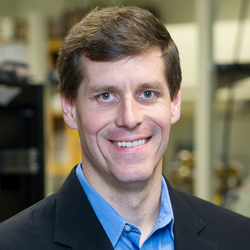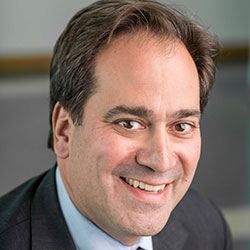Four Professors Included in PNAS Special Materials Feature
Work by Mark Hersam, Yonggang Huang, Chad Mirkin, and John Rogers appear in the Novel Materials Special Feature
Northwestern University researchers know the future of novel materials – so much so that the Proceeding of the National Academy of Sciences (PNAS) selected three Northwestern Engineering papers — from four professors — for its Novel Materials Special Feature.

Published in PNAS this month, Rogers and Huang co-authored a paper describing a set of materials for flexible electronic systems that can serve as novel classes of biomedical implants with capabilities for long-term, high-performance operation in the body. The key advance is in the development of ultrathin layers of material that perfectly seal the devices from surrounding biofluids, with projected lifetimes that exceed 50 years.
“Thin, flexible sheets of electronics that laminate onto vital organs of the human body offer radically new and powerful engineering design opportunities for future generation pacemakers, deep brain stimulators, and other even more advanced types of implants,” said Rogers, the Louis Simpson and Kimberly Querrey Professor of Materials Science and Engineering, Biomedical Engineering, and Neurological Surgery. “A long-standing challenge is in constructing such flexible systems in ways that prevent penetration of biofluids into the active electrodes, with robust operation throughout the life of the patient.”

The paper, “Ultrathin, transferred layers of thermally grown silicon dioxide as biofluid barriers for biointegrated flexible electronic systems,” was supported by the Defense Advanced Research Projects Agency, National Science Foundation, and Army Research Office. Hui Fang, Jianing Zhao, and Enming Song, all members of Rogers’ group, were co-first authors of the paper.
Published in PNAS in April, Hersam’s work demonstrated a new way to exfoliate thinner flakes of phosphorene at higher yield. While phosphorene shows great promise for thin, flexible electronics, it must be incredibly thin to reach its full potential.

When exposed to open air, the chemical reactivity of phosphorene leads to rapid deterioration. The result suggests that components of air, such as water and oxygen, are driving degradation and need to be avoided. Consequently, Hersam initially bypassed this issue by exfoliating with organic solvents in a closed, air-free, and water-free environment.
The breakthrough came when Hersam and his team realized — after a year of studying the degradation process — that phosphorene degrades in the presence of both water and oxygen together. By bubbling an inert gas through water, Hersam deoxygenated it to create an aqueous solvent for exfoliating black phosphorous that avoids degradation. After sonicating black phosphorous in a mixture of deoxygenated water and surfactants, he found substantially higher exfoliation yield and much thinner flakes that reached the atomically thin limit.
The paper, “Stable aqueous dispersions of optically and electronically active phosphorene,” was supported by the National Science Foundation and Office of Naval Research. Joohoon Kang, a graduate student in Hersam’s laboratory, was first author of the paper.

“Uniformity is of both practical and functional importance, necessary to increase structural sophistication and realize the promise of nanostructured materials,” Mirkin and his co-authors wrote. “Thus, we define the nature of nonuniformity at each length scale as a means to guide ongoing research efforts and highlight potential problems in the field.”
The paper “The nature and implications of uniformity in the hierarchical organization of nanomaterials” included material supported by the Air Force Office of Scientific Research and the National Science Foundation.